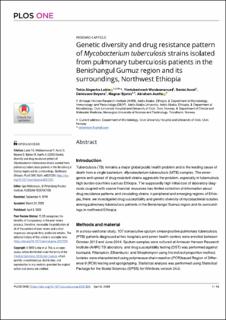| dc.contributor.author | Lobie, Tekle Airgecho | |
| dc.contributor.author | Woldeamanuel, Yimtubezinash | |
| dc.contributor.author | Asrat, Daniel | |
| dc.contributor.author | Beyene, Demissew Balcha | |
| dc.contributor.author | Bjørås, Magnar | |
| dc.contributor.author | Aseffa, Abraham | |
| dc.date.accessioned | 2021-02-05T08:53:20Z | |
| dc.date.available | 2021-02-05T08:53:20Z | |
| dc.date.created | 2021-01-28T12:01:27Z | |
| dc.date.issued | 2020 | |
| dc.identifier.citation | PLOS ONE. 2020, 15 (4), . | en_US |
| dc.identifier.issn | 1932-6203 | |
| dc.identifier.uri | https://hdl.handle.net/11250/2726324 | |
| dc.description.abstract | Introduction
Tuberculosis (TB) remains a major global public health problem and is the leading cause of death from a single bacterium, Mycobacterium tuberculosis (MTB) complex. The emergence and spread of drug-resistant strains aggravate the problem, especially in tuberculosis high burden countries such as Ethiopia. The supposedly high initial cost of laboratory diagnosis coupled with scarce financial resources has limited collection of information about drug resistance patterns and circulating strains in peripheral and emerging regions of Ethiopia. Here, we investigated drug susceptibility and genetic diversity of mycobacterial isolates among pulmonary tuberculosis patients in the Benishangul Gumuz region and its surroundings in northwest Ethiopia.
Methods and material
In a cross-sectional study, 107 consecutive sputum smear-positive pulmonary tuberculosis (PTB) patients diagnosed at two hospitals and seven health centers were enrolled between October 2013 and June 2014. Sputum samples were cultured at Armauer Hansen Research Institute (AHRI) TB laboratory, and drug susceptibility testing (DST) was performed against Isoniazid, Rifampicin, Ethambutol, and Streptomycin using the indirect proportion method. Isolates were characterized using polymerase chain reaction (PCR)based Region of Difference 9 (RD9) testing and spoligotyping. Statistical analysis was performed using Statistical Package for the Social Sciences (SPSS) for Windows version 24.0.
Results
Of 107 acid-fast-bacilli (AFB) smear-positive sputum samples collected, 81.3% (87/107) were culture positive. A PCR based RD9 testing revealed that all the 87 isolates were M. tuberculosis. Of these isolates, 16.1% (14/87) resistance to one or more drugs was observed. Isoniazid monoresistance occurred in 6.9% (6/87). Multidrug resistance (MDR) was observed in two isolates (2.3%), one of which was resistant to all the four drugs tested. Spoligotyping revealed that the majority, 61.3% (46/75) of strains could be grouped into ten spoligotype patterns containing two to 11 isolates each while the remaining 38.7% (29/75) were unique. SIT289 (11 isolates) and SIT53 (nine isolates) constituted 43.5% (20/46) among clustered isolates while 29.3% (22/75) were ‘‘New” to the database. The dominant families were T, 37% (28/75), CAS, 16.0% (12/75), and H, 8% (6/75), adding up to 51.3% (46/75) of all isolates identified.
Conclusion and recommendations
The current study indicates a moderate prevalence of MDR TB. However, the observed high monoresistance to Isoniazid, one of the two proxy drugs for MDR-TB, reveals the hidden potential threat fora sudden increase in MDR-TB if resistance to Rifampicin would increase. Clustered spoligotype patterns suggest ongoing active tuberculosis transmission in the area. The results underscore the need for enhanced monitoring of TB drug resistance and epidemiological studies in this and other peripheral regions of the country using robust molecular tools with high discriminatory power such as the Mycobacterial Interspersed Repetitive Units -Variable Number of Tandem Repeats (MIRU-VNTR) typing and whole-genome sequencing (WGS). | en_US |
| dc.language.iso | eng | en_US |
| dc.publisher | PLOS, Public Library of Science | en_US |
| dc.rights | Navngivelse 4.0 Internasjonal | * |
| dc.rights.uri | http://creativecommons.org/licenses/by/4.0/deed.no | * |
| dc.title | Genetic diversity and drug resistance pattern of Mycobacterium tuberculosis strains isolated from pulmonary tuberculosis patients in the Benishangul Gumuz region and its surroundings, Northwest Ethiopia | en_US |
| dc.type | Peer reviewed | en_US |
| dc.type | Journal article | en_US |
| dc.description.version | publishedVersion | en_US |
| dc.source.pagenumber | 16 | en_US |
| dc.source.volume | 15 | en_US |
| dc.source.journal | PLOS ONE | en_US |
| dc.source.issue | 4 | en_US |
| dc.identifier.doi | 10.1371/journal.pone.0231320 | |
| dc.identifier.cristin | 1881146 | |
| dc.description.localcode | Copyright: © 2020 Lobie et al. This is an open access article distributed under the terms of the Creative Commons Attribution License, which permits unrestricted use, distribution, and reproduction in any medium, provided the original author and source are credited. | en_US |
| cristin.ispublished | true | |
| cristin.fulltext | original | |
| cristin.qualitycode | 1 | |

